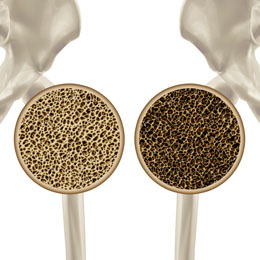There are many women in the world today who are affected by Osteoporosis and don't really know what to do with a condition like this. Let's understand this medical condition in this article.

Osteoporosis is to a disease, where the bones become fragile and are more likely to break. If not prevented or if left untreated, osteoporosis can progress painlessly until a bone breaks. These broken bones, also known as fractures, occur typically in the hip, spine, and wrists.
In a condition like this, any bone can be affected, but bones that are of special concern are fractures of the hip and spine. A hip fracture almost always requires hospitalization and a major surgery. It can impair a person's ability to walk unassisted and may cause prolonged or permanent disability. Spinal or vertebral fractures also have serious consequences, including loss of height, severe back pain, and deformity.
Causes and Solutions
Osteoporosis is typically a bone disease where the density of the bone is reduced and the structural integrity of trabecular bone is impaired. Cortical bone becomes more porous and thinner with time. This makes the bone weaker and more prone to fractures. The extent of Osteoporosis can be measured on the basis of bone density. Using standardized bone density measurements of the total hip, the normal bone density is greater than 833 mg/cm2.
Osteoporosis is more common today than it should be. Although we don't know how to completely stop the bone loss, we can take steps to prevent many of the fractures. The prevention starts in childhood, with good nutrition and exercise. Adequate dietary intake of calcium and vitamins A,C,D and E are equally important. There are many medical papers that focus on medications to be administered for reducing the rate of bone loss. Most articles lay emphasis on stress and lifestyle issues such as diet and exercise. However, what's most important to note is that a combination of diet and exercise is what contributes to the prevention of fractures.
Sometimes doctors want their patients to take a medication for osteoporosis, without paying attention to these basic building blocks. The medications will not be as effective if there is inadequate calcium, exercise, and nutrition.
If a supplement is prescribed, then it should be one with good dissolution. Chewable tablets are a safe bet. TUMS (or generic chewable calcium carbonate) would also be another important recommendation as it is the most affordable form of calcium carbonate. Because calcium is absorbed better with food, it should be given with meals. The best bet for you would be to have it in a combination with vitamin E after dinner at night, as it induces good sleep as well.


 Osteoporosis is to a disease, where the bones become fragile and are more likely to break. If not prevented or if left untreated, osteoporosis can progress painlessly until a bone breaks. These broken bones, also known as fractures, occur typically in the hip, spine, and wrists.
Osteoporosis is to a disease, where the bones become fragile and are more likely to break. If not prevented or if left untreated, osteoporosis can progress painlessly until a bone breaks. These broken bones, also known as fractures, occur typically in the hip, spine, and wrists.